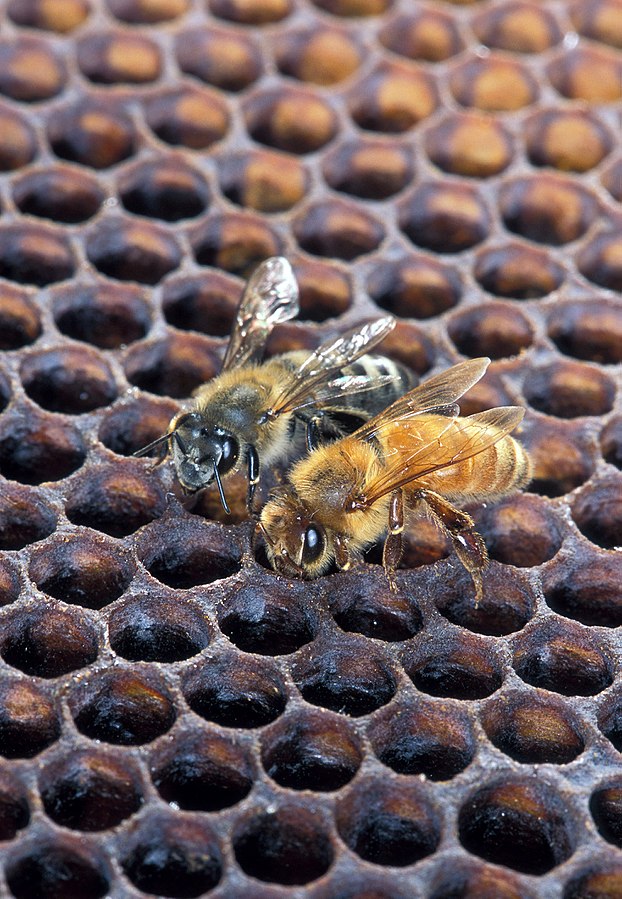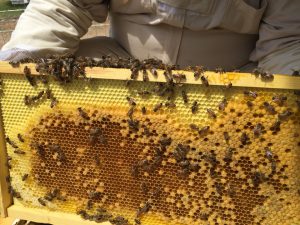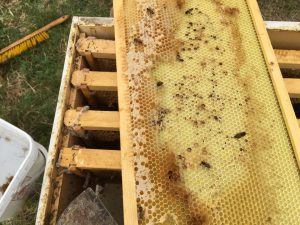Where Did the Africanized Honey Bees come from and What’s up Now?
By Sy Maher
Something to know. The African bee and the Africanized bee are not the same kinds of a bee. The bee that comes from Africa, or rather from South Africa is as plain as that, a South African Bee. Aggressive yes, but from Africa. An Africanized bee is a hybrid that results from African and European bees mating (European bees are sometimes referred to as the Western honey bees).

A little history. Dr. Warwick Estevam Kerr, a geneticist, began working with African bees. These bees were brought to Brazil in 1950 to be crossbred with non-tropical honey bees. His work in crossbreeding was meant to improve the bees production of wax and honey. The hive area where his work took place had been fitted with special screens to keep the bees from getting out of the test area.

The bee on the left is an Africanized honeybee, and the bee on the right is a European one.
Due to an unfortunate accident, twenty-six swarms escaped a quarantined environment. There are different spins to how these bees actually escaped. One account is that while shipping the gentler hybrid queens, they died, which led to the shipping of more aggressive queens. Another report is that twenty-six queens and their daughters were distributed across the country to Brazilians farmers. Yet another version of the story is that a local beekeeper noticed that the Africanized queens and drones were leaving their containment area. Their offspring have since spread to the warm regions of Central America. It is nearly impossible to tell the difference between an Africanized honey bee and a Western or European honey bee.
In many parts of the United States, beekeepers look at their hives in the spring to see if the bees have become crowded and are getting ready to swarm (leave the nest with the old queen to find a new home). At that point, they split the hive by providing a new home. The simplest way to split a hive is by removing several frames of brood (The brood comb is the beeswax structure of cells where the queen bee lays eggs.), bees and food sources taken from a strong hive and placed in an empty hive. Other considerations have to do swarmings, such as beekeeper preference, region, and time of year.
Here in Arizona, as in many southern states, we have a longer growing period and warm weather so bees can find food, increase in number and swarm many times for beekeepers. The wild Africanized honey bee has an even faster reproduction rate and can swarm up to ten times a year.
The first AHB was discovered in California at an oil field in the San Joaquin Valley. “Bee experts theorized the colony had arrived hidden in a load of oil-drilling pipe shipped from South America.” They were next discovered in Texas and in the Tucson region of Arizona, a study of trapped swarms in 1994 found that only 15 percent had been Africanized; this number had grown to 90 percent by 1997.
In their defense, Africanized bees are reported to be superior honey producers and genetically tougher than their European counterparts in the US. However, they cannot survive cold weather and need extended periods to forage making it less likely for the bees to spread to some regions. In the south, they swarm frequently and are more likely to abandon a nest in search for another home closer to food sources. They don’t require a large place, so they sometimes choose a meter box, old tires, trees, chimneys and crawl spaces under houses or buildings for a home, to name but a few.
Their alarm zone (how close you can get to a nest before the bees react), is bigger than the European honey bee. AHB’s are super defensive, guard the hive aggressively, and respond quickly to disturbances at a minimum distance fifty-feet away from their nesting site. One-hundred feet or more if there are vibrations from power equipment including such things as leaf blowers and lawn mowers. They also deploy many more bees in defense of the hive and pursue their target(s) for a longer distance. Some reports state that the AHB has pursued persons up to a mile away from the hive.
In populated urban regions, the AHB has become a potential for danger. Their sting is slightly less venomous than a regular honey bee, but what makes them dangerous is the sheer number of bees that will attack to defend their hive. It is also why not every bee rescue is successful as the rescue may pose a danger to the bee technician. In Arizona, always assume that the bees that live here are 100% Africanized. Use caution if you see any Bee Colony near your location. Call 911, or your local fire department. Know what to do when an Africanized honey bee attacks! Do not try to rectify the problem, call a professional.
Sources
https://en.wikipedia.org/wiki/Africanized_bee#History
http://entnemdept.ufl.edu/creatures/misc/bees/ahb.htm
http://articles.latimes.com/1989-05-10/news/mn-2787_1_africanized-killer-bees-san-diego-county
http://apisenterprises.com/papers_htm/Misc/AHB%20in%20the%20Americas.htm
http://edis.ifas.ufl.edu/in784
https://www.honeybeesonline.com/making-spring-splits/
https://sites.google.com/site/venomousdangerous/insects/africanized-honey-bees


